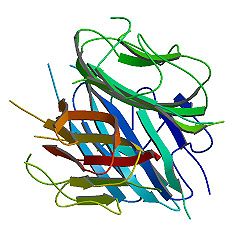
Adiponectin

4DOU937011450ENSG00000181092ENSMUSG00000022878Q15848Q60994NM_001177800NM_004797NM_009605NP_001171271NP_004788NP_033735Adiponectin (also referred to as GBP-28, apM1, AdipoQ and Acrp30) is a protein hormone which is involved in regulating glucose levels as well as fatty acid breakdown. In humans it is encoded by the ADIPOQ gene and it is produced in adipose tissue. Adiponectin (also referred to as GBP-28, apM1, AdipoQ and Acrp30) is a protein hormone which is involved in regulating glucose levels as well as fatty acid breakdown. In humans it is encoded by the ADIPOQ gene and it is produced in adipose tissue. Adiponectin is a 247-amino-acid-long polypeptide (protein). There are four distinct regions of adiponectin. The first is a short signal sequence that targets the hormone for secretion outside the cell; next is a short region that varies between species; the third is a 65-amino acid region with similarity to collagenous proteins; the last is a globular domain. Overall this protein shows similarity to the complement 1Q factors (C1Q). However, when the 3-dimensional structure of the globular region was determined, a striking similarity to TNFα was observed, despite unrelated protein sequences. Adiponectin is a protein hormone that modulates a number of metabolic processes, including glucose regulation and fatty acid oxidation. Adiponectin is secreted from adipose tissue (and also from the placenta in pregnancy) into the bloodstream and is very abundant in plasma relative to many hormones. Many studies have found adiponectin to be inversely correlated with body mass index in patient populations. However, a meta analysis was not able to confirm this association in healthy adults. Circulating adiponectin concentrations increase during caloric restriction in animals and humans, such as in patients with anorexia nervosa. This observation is surprising, given that adiponectin is produced by adipose tissue. However, a recent study suggests that adipose tissue within bone marrow, which increases during caloric restriction, contributes to elevated circulating adiponectin in this context. Transgenic mice with increased adiponectin show reduced adipocyte differentiation and increased energy expenditure associated with mitochondrial uncoupling. The hormone plays a role in the suppression of the metabolic derangements that may result in type 2 diabetes, obesity, atherosclerosis, non-alcoholic fatty liver disease (NAFLD) and an independent risk factor for metabolic syndrome. Adiponectin in combination with leptin has been shown to completely reverse insulin resistance in mice. Adiponectin is secreted into the bloodstream where it accounts for approximately 0.01% of all plasma protein at around 5-10 μg/mL (mg/L). In adults, plasma concentrations are higher in females than males, and are reduced in diabetics compared to non-diabetics. Weight reduction significantly increases circulating concentrations. Adiponectin automatically self-associates into larger structures. Initially, three adiponectin molecules bind together to form a homotrimer. The trimers continue to self-associate and form hexamers or dodecamers. Like the plasma concentration, the relative levels of the higher-order structures are sexually dimorphic, where females have increased proportions of the high-molecular weight forms. Recent studies showed that the high-molecular weight form may be the most biologically active form regarding glucose homeostasis. High-molecular-weight adiponectin was further found to be associated with a lower risk of diabetes with similar magnitude of association as total adiponectin. However, coronary artery disease has been found to be positively associated with high molecular weight adiponectin, but not with low molecular weight adiponectin. Adiponectin exerts some of its weight reduction effects via the brain. This is similar to the action of leptin; adiponectin and leptin can act synergistically. Adiponectin binds to a number of receptors. So far, two receptors have been identified with homology to G protein-coupled receptors, and one receptor similar to the cadherin family: These have distinct tissue specificities within the body and have different affinities to the various forms of adiponectin. The receptors affect the downstream target AMP kinase, an important cellular metabolic rate control point. Expression of the receptors is correlated with insulin levels, as well as reduced in mouse models of diabetes, particularly in skeletal muscle and adipose tissue.. In 2016, the University of Tokyo announced it was launching an investigation into anonymously made claims of fabricated and falsified data on the identification of AdipoR1 and AdipoR2.
